[Affiliate Disclosure: We receive a commission if you purchase something through one of the links above! Affiliate commission is one of the ways we keep the lights on here at PA — it also helps us provide tons of useful free content and 100% free proofreader referral services.]

One of the amazing benefits of working from home is that it gives freedom and flexibility that most jobs don’t offer. The problem is, so many people don’t embrace the benefits of their stay-at-home job. Instead, they fall prey to a weak social life, poor health, and stalled professional growth.
So, why not take advantage of your flexibility and improve your health and happiness?
In this article, we hope to inspire you to take advantage of the health benefits of working from home by exercising in a fun and easy way. Yoga, dance workouts, and jogging are just a few ways you can make working from home the healthiest choice you’ve made.
Health Benefits of Regular Exercise
People who work from home would probably make the best designers for ergonomic desks because we all know how easy it is to slide into poor posture habits. A damaging posture and inactivity can lead to physical and mental health problems.
Mayo Clinic research shows that working at a desk for long periods of time has been known to cause several health issues, including neck, back, and shoulder pain, mental fatigue, and increased risk of heart disease and dementia.
According to the Centers for Disease Control and Prevention (CDC), adults need at least 150 minutes of moderate-intensity physical activity per week, combined with two days of muscle strengthening, to avoid health problems related to sitting for long periods.
An active lifestyle can help you alleviate anxiety, improve cognition, and reduce your risk of developing type 2 diabetes and cancer.
Staying active on the job is a great way to improve your health in every aspect of your life and you only need to throw in a few exercises scattered throughout your day.
Fun Work-from-Home Exercises
There’s a wide range of fun work-from-home exercises to choose from. Exercises like spinning and leg lifts are ideal for people looking to build muscle strength, improve mobility and balance, lose excess weight, and even improve cardiovascular health.
Most of the work-from-home exercises below are suitable for beginners and don’t require lots of equipment.
Choose the right exercise by listening to your body’s needs and consulting your healthcare provider about what’s best for you. People with back injuries should avoid vigorous activities such as dance workouts and jogging. Instead, opt for gentler exercises like yoga and other low-impact exercises.
Yoga
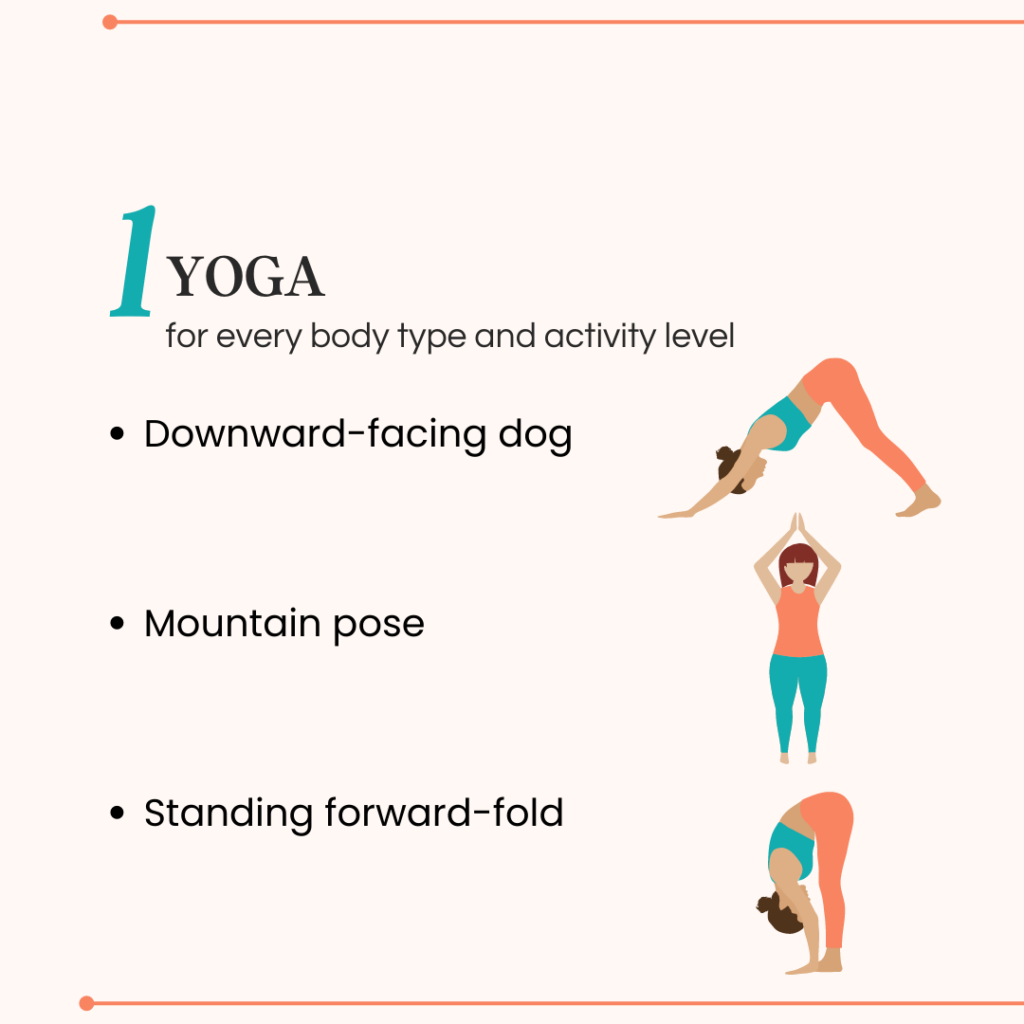
The practice of yoga combines specific poses, breathing techniques, and meditation to improve both physical and mental well-being. Yoga is widely practiced for benefits like stress relief, increasing muscle strength, improving flexibility, and balancing energy. Studies have shown that yoga can also help build balance and reduce back pain.
To practice yoga, you’ll need minimal equipment. An extra-thick mat provides a comfortable, slip-resistant surface to do the exercises. You can use a yoga bolster, yoga strap, or yoga block to adapt different exercises to your ability. You can also use a chair, stool, stack of books, a rolled-up blanket, a belt, or a scarf if you don’t want to buy new equipment.
There are several yoga types to choose from and nearly every pose can be adapted to fit any fitness level.
We’ve focussed on the following poses for releasing back pain and getting your blood pumping.
Downward-Facing Dog
The downward-facing dog pose is ideal for strengthening hamstrings, calves, arms, and legs. This pose can also help improve posture and stimulate blood flow.
- Begin on all fours. Your hands should be shoulder-width apart, and your knees should be underneath your hips. Keep your hands flat against the mat
- While taking deep breaths, lift your knees and straighten your legs as much as possible. When performed correctly, your body should look like an upside-down “V”
- Extend your spine as much as you can while pressing into your palms and the balls of your feet
- Relax the muscles in your neck and face
- Hold this position for a few deep breaths. Then, release by slowly bringing your knees back down to the mat
Downward-facing dog can be challenging on the joints and shouldn’t be performed by people with shoulder, knee, ankle, hip, or spinal injuries.
To see more information, check out this tutorial from Yoga with Adriene.
Mountain Pose
This straightforward standing pose targets the full body and is ideal for beginners or people with less flexibility.
- Stand with your feet together, heels slightly apart, and your big toes gently touching
- Gently lift and rotate your thighs inwards. Keep your legs straight and make sure not to lock your knees.
- Push into your feet, take a deep breath, and roll your shoulders up to your ears and then downward
- Let your arms relax and hang naturally, with palms facing forward.
- Hold this position for 5 to 10 deep breaths, then release
Take caution or avoid this balancing exercise if you experience insomnia, low blood pressure, general lightheadedness, or other situations that make balancing difficult.
This video shows mountain pose in action.
Standing Forward-Fold Pose
The standing forward-fold is particularly great for people looking to improve their balance or strengthen their thighs and knees.
- Start in the mountain pose, keeping your hands on your hips
- Take a deep breath, and while exhaling, slightly bend your knees and fold your torso over your legs. Allow your palms to lay against your shins, feet, or the mat
- Straighten your legs as much as possible
- Release the position after 5 to 10 breaths
Forward-fold is explained perfectly in this video.
Dance Workout
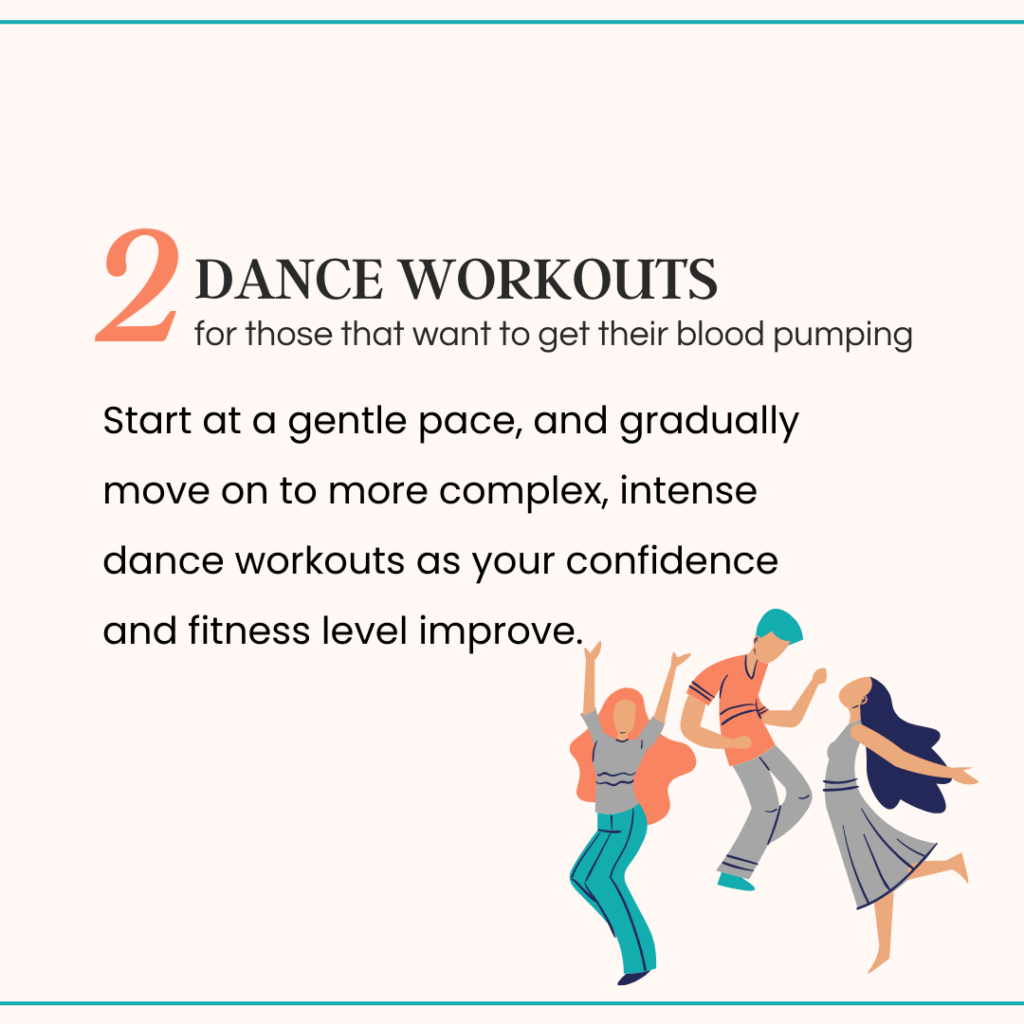
A dance workout is a fun and creative way to get your body moving and increase your endurance, muscle strength, and aerobic fitness. The activity is particularly ideal for people trying to lose weight.
There are plenty of 5- to 15-minute dance workouts on Youtube, and it’s easy to find a routine that suits your fitness level, schedule, and goals. Start at a gentle pace, and gradually move on to more complex, intense dance workouts as your confidence and fitness level improve.
Most dance workouts don’t require special equipment, though it’s important to have an open space, free of obstructions.
People with knee, hip, or ankle injuries should be extra cautious when dancing and take things slowly. Avoid dance workouts if they cause discomfort or pain.
Spinning at Home
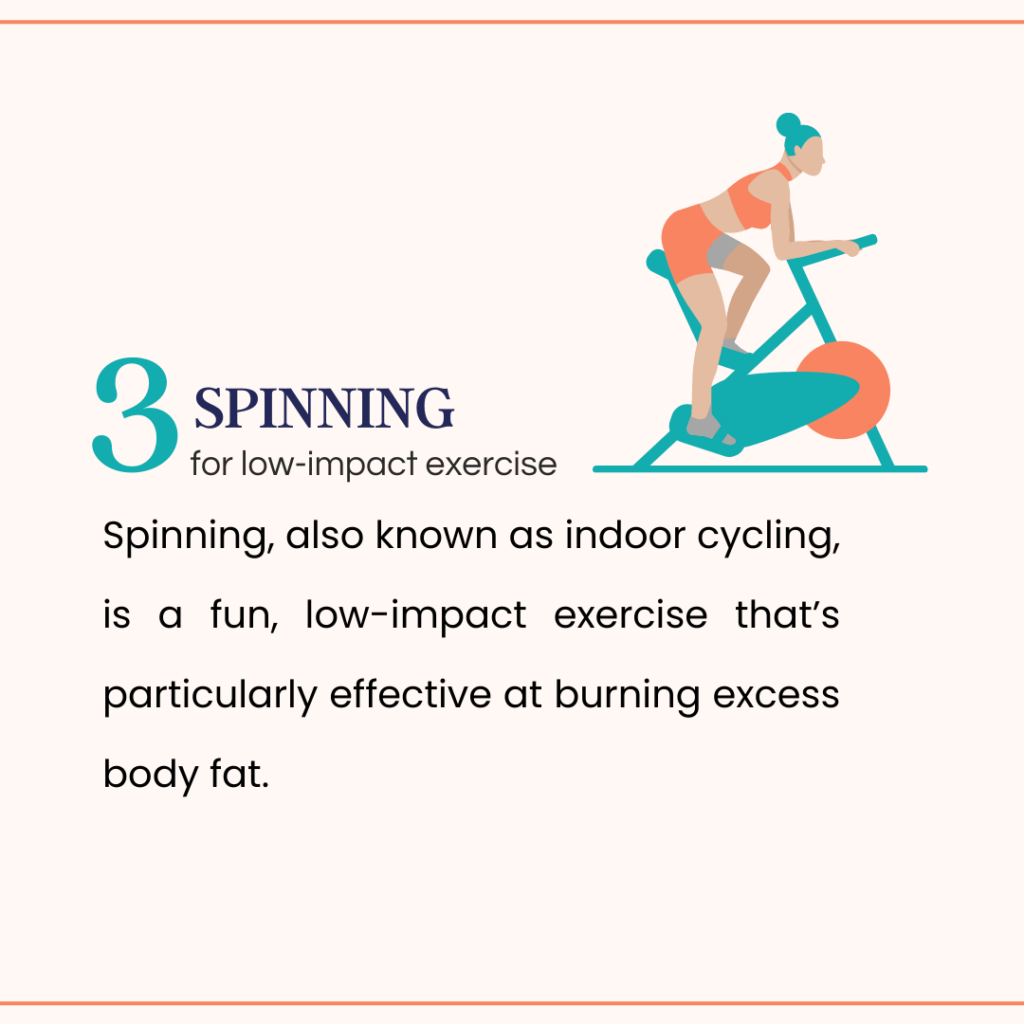
Spinning, also known as indoor cycling, is a fun, low-impact exercise that’s particularly effective at burning excess body fat. Other health benefits include toned legs, reduced stress, and improved heart health.
Spinning requires a stationary exercise bike, also called a spin bike. Spin resistance can be adjusted on most bike models to control the exercise intensity. Spin bikes range between $700 and $2,000.
Here’s a fun spin workout to try while working from home:
- Start with a 3-minute warm-up at a light or moderate pace that feels appropriate for your fitness level
- Follow with a 30-second sprint and then a 30-second light cycle. Alternate between these two for 3 to 6 minutes
- Next, spin for 3 minutes at a moderate pace
- Repeat 1 to 3 three times, reducing the spin resistance and incorporating more breaks as needed
- End with a 3-minute cooldown at a gentle, easy pace
Spin bikes are a great way to exercise for most fitness levels, however, the bike isn’t suitable for people healing from hip injuries.
Jogging In Place
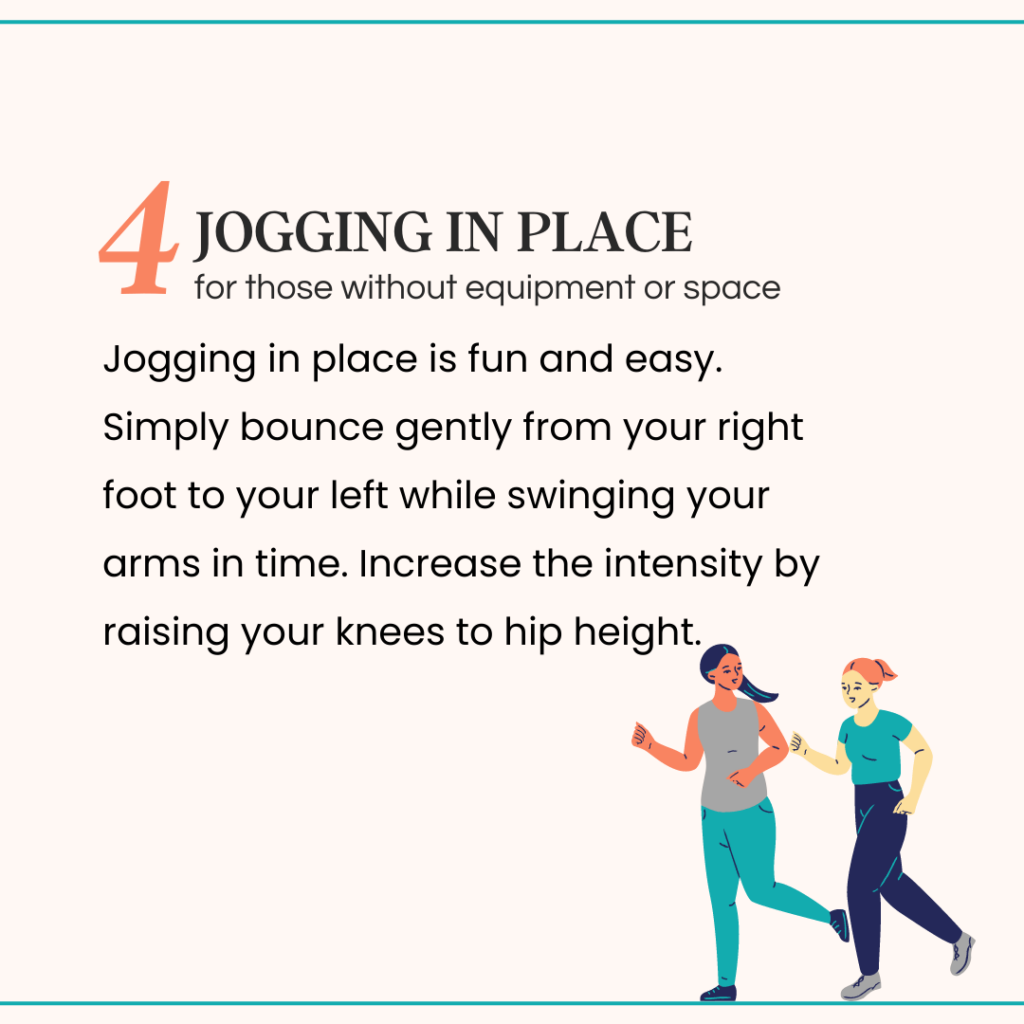
Jogging is an aerobic exercise that strengthens muscles, builds a strong core, and boosts cardiovascular function. Jogging on the spot requires minimal space and doesn’t require equipment — an ideal exercise in a small apartment or home office space.
Jogging in place is fun and easy. Simply bounce gently from your right foot to your left while swinging your arms in time. Increase the intensity by raising your knees to hip height.
Keep the exercise exciting by jogging in 3-minute intervals and alternating the speed to keep it challenging. Jogging in place is a great exercise to do when you take a short break from your desk, and it’s fun to do while listening to music or a podcast to give your mind a break.
This work-from-home activity is suitable for most fitness levels, however, people with shin, hip, or ankle problems should approach this exercise cautiously.
Sitting Exercises
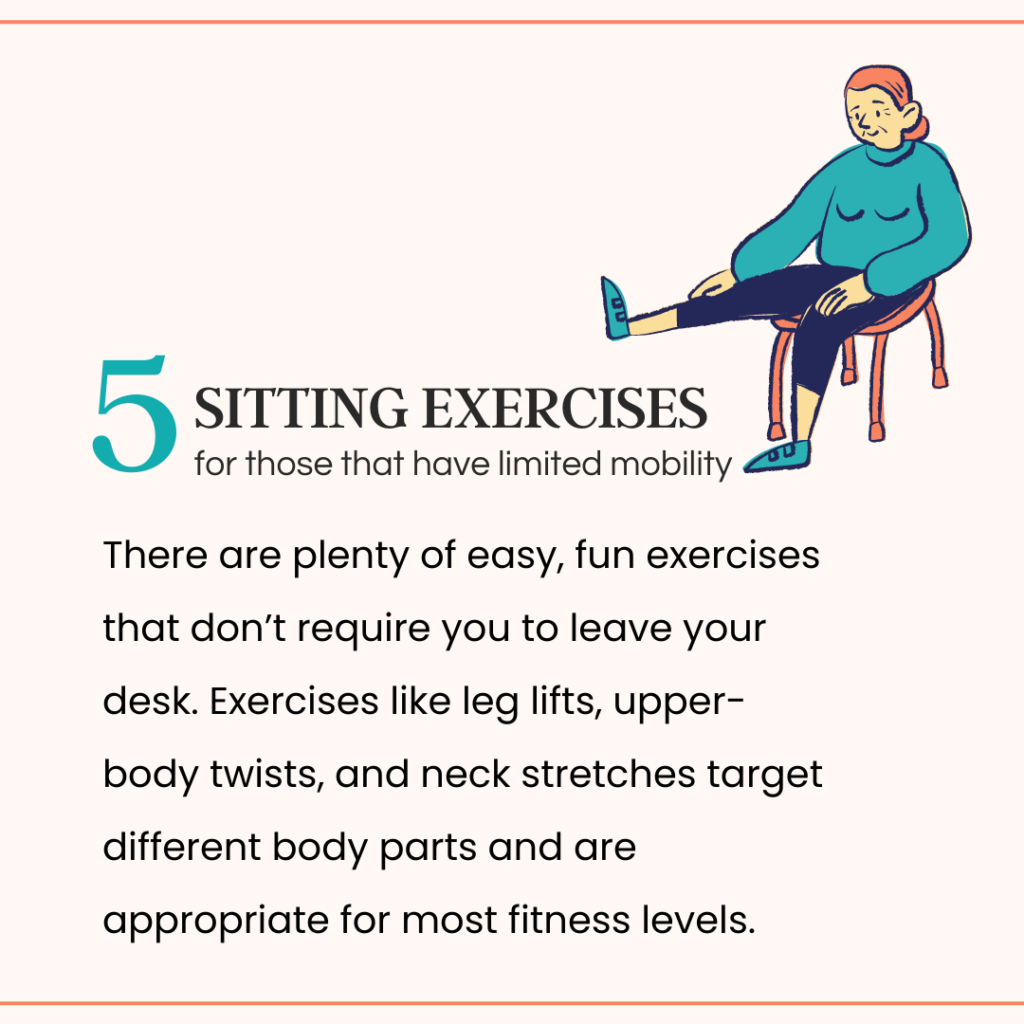
There are plenty of easy, fun exercises that don’t require you to leave your desk. Exercises like leg lifts, upper-body twists, and neck stretches target different body parts and are appropriate for most fitness levels.
Here are several stretches to try from your desk if you’re on a roll and can’t put your project down.
Neck Stretches
Stretching the neck helps loosen stiff neck muscles, relieve pain, and enhance flexibility.
- Sit upright, look directly ahead, and place your right hand on your left shoulder
- Hold your shoulder down and slowly roll your head to the right. Release after 5 seconds
- Do the same on the other side and then repeat 3 to 5 times
Seated Leg Lifts
Leg lifts target the lower core, resulting in strengthened hips and better leg and core flexibility that results in good posture.
- Sit upright and stretch out your legs
- While leaning back, gradually raise both legs up. Or, raise one leg at a time to reduce the intensity
- Hold your leg(s) up for a few seconds, then lower slowly
- Repeat 3 times in sets of 10
Upper-Body Twists
Upper-body twists help improve flexibility and release tension in the upper back.
- While sitting, keep your feet firmly on the floor and cross your arms. Your hands should rest just below your shoulders
- Gently twist your upper body to the left without moving your hips. Hold the stretch for 5 seconds
- Repeat on the opposite side
- Do 3 to 5 sets on each side
Jumping Jacks
Jumping jacks or star jumps are a simple way to exercise the entire body. The exercise seems old-fashioned, but it’s hardly gone out of style — it helps the body in many ways, including improving coordination, burning calories, increasing bone density, and strengthening muscles.
- Stand with your arms at your sides and jump to a star position with your arms and legs wide
- Jump back to your starting position with your arms at your sides
- Repeat as fast as you can go!
While this is an ideal activity for most, jumping jacks aren’t suitable for people with weak knees or shoulder problems.
Simple Ways to Get Your Body Moving
There are plenty of simple ways to get your body moving, including walking during calls, taking the stairs, and doing daily stretches whenever you have spare time.
- Take the stairs: Taking the stairs instead of the escalator or elevator helps build balance and muscle stamina. In fact, climbing more than 55 flights per week could even help lengthen your life. If you want to target glute and core muscles, do quick step-ups while climbing the stairs
- Stretch daily: Find creative ways to safely stretch your body during everyday tasks, like making coffee, doing the laundry, or watching TV
- Jog to the shops: Lightly jogging to the shops is an easy way to get a cardio workout in and burn calories. Alternate between a brisk and gentle pace, and mix it up with some walking lunges
- Walk during work calls: Walking regularly helps to maintain a healthy weight, prevents heart diseases, and improves general cardiovascular fitness
- Stand instead of sitting: Sitting for long periods can lead to several health problems. Make it a habit to take a break from sitting every 30 minutes or invest in a standing desk. Standing up regularly can help motivate you to stretch and exercise more — a double benefit
- Join an online gym class: There are plenty of online, weekly gym classes that you can participate in. Join classes that tailor to your fitness level and goals. For example, you could consider joining an online martial arts class
- Play sports games with your kids: Playing sports with your kids at home is a great way to bond with the family and stay fit. Ideal outdoor sports games you can play in your yard include badminton, frisbee, and soccer. Suitable indoor activities include table tennis, ring toss, and balloon games
Work from Home Exercise Equipment
Video meetings, busy schedules, and working late at night can keep you from caring for your physical health. However, investing in work-from-home exercise equipment allows you to keep fit even if you can’t get away from your desk.
Exercise equipment, while effective, can be expensive. To get inspired, check out how this work-at-home mom makes money from home while balancing her family’s routine.
Under-Desk Treadmills
An under-desk treadmill fits underneath a stand-up desk to be used while working. Most under-desk treadmills run up to 4 mph, can withstand miles of usage, and typically cost between $400 and $3,000. Some under-desk treadmills are compact and portable, while others feature a built-in desk setup.
Under-desk treadmills are available online:
An under-desk treadmill is ideal if you’re looking to reduce body weight, stabilize blood sugar levels, and improve circulation.
Stationary Desk Bikes
A stationary desk bike is a standard exercise bike with a built-in laptop desk. Stationary desk bikes can help burn calories, strengthen leg muscles, and reduce cholesterol levels.
This equipment is particularly great for people looking for a low-impact exercise that’s easier on the joints than running. Most stationary desk bikes come with adjustable, ergonomic seats and cost between $300 and $1,500.
Buy stationary desk bikes online:
If you experience back pain, consider models that offer back support.
Dumbbells
Dumbbells are ideal at-home exercise equipment for people looking to strengthen and tone. They’re typically affordable, can easily be used while working from home at a desk, and come in various styles, shapes, materials, and weights.
Dumbbells typically cost up to $100. Heavier weights (over 5kg) cost more than lighter weights (between 1 and 4kg). Dumbbells are sold widely on Amazon.
Under-Desk Ellipticals
An under-desk elliptical is a stationary exercise equipment that’s similar to other aerobic activities, like running, walking, and jogging, but it’s gentler on the joints.
Under-desk ellipticals typically cost between $120 and $400, depending on features, materials, and resistance settings. The equipment can be bought from Walmart and Amazon.
How to Get Back to Working Out
Rushing into an intense exercise can cause burnout, stress, or even injuries. It’s important to go slow, keep to your limits, and start with low-impact activities.
Here are a few more tips and tricks to help you get back into working out safely:
- Modify activities to better suit your fitness level, stamina, and physical health
- Seek a qualified fitness instructor to help you develop a plan that tailors to your individual needs and goals
- Take breaks between exercises
- Start with 5-minute workouts and build up gradually
- Consult a doctor before starting any new exercise activities, especially if you suffer from health problems
- Find an exercise buddy to keep yourself motivated
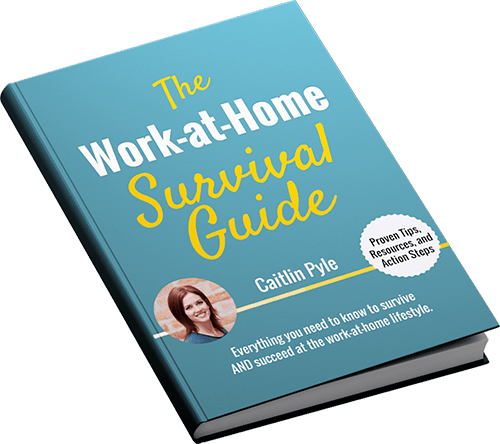
Exercising can be difficult if you don’t have a healthy work-life balance — our Work from Home Survival Guide can give you the tips to achieve just that.
Are you ready to take advantage of the health benefits that come with working from home?
Tag us on Instagram or Facebook to meet like-minded people and show us how you stay active at home. We offer general tips for work-at-home professionals like you on staying active at your job.

I found your post to be interesting. I want to read more of your shares like this in the future. Thanks.
I am thrilled to have discovered this helpful website. It provides me with a great deal of interesting information about everything, notably the content of the preceding article.
The information you bring is very real, reflecting things correctly and objectively, and it helps society grow